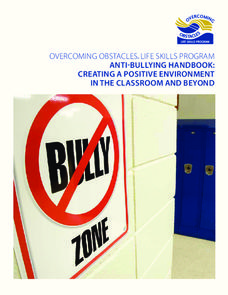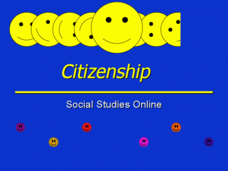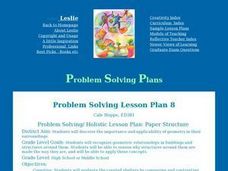Royal Conservatory of Music
The Anti-bullying Magazine
Get the word out about friendship, support, and a safe school community with a media literacy lesson about bullying. Young journalists investigate instances of bullying and take descriptive pictures as they compile a magazine to fight...
US Institute of Peace
Defining Conflict
Conflict is everywhere—but is it avoidable? The first activity in a series of 15 peacebuilding lessons examines the nature of conflict at home, school, and across the world. Learners develop a definition of conflict through group work...
Teaching Tolerance
Community Newsletter
What does it take to develop and publish a newsletter? Young academics create a newsletter with original artwork for their school or community. They explore social justice themes and spread messages of tolerance and inclusion. Scholars...
Teaching Tolerance
Journalism for Justice
Roll the presses! Or at least have your class members participate in the time-honored tradition of the student press by creating their own newspapers or journalist pieces on a social problem. After conducting research and collaborating...
Nebraska Department of Education
Goal Maps
High school freshmen are asked to think about their future goals and reflect on what they have learned about the barriers they may face and the resources they have to overcome these barriers. Individuals then respond to questions on a...
Overcoming Obstacles
Anti-Bullying Handbook: Creating a Positive Environment in the Classroom and Beyond
A hot-button topic in schools today is bullying, and although there is heightened awareness of this problem, information about specific steps schools can take to combat the problem and create a positive environment is difficult to find....
Department of Education (Ireland)
Consequences
11 lessons, designed to be used in consecutive order, ask middle and high school scholars to consider the effects of various drugs and the consequences of taking them for themselves and their families. They also develop the communication...
Advocates for Human Rights
All about Me!
Celebrate the uniqueness of your students with this character building lesson series. In order to learn about and appreciate diversity and individuality, children create All About Me books by cutting out and drawing pictures...
Career Solutions Publishing
It’s For Real Workplace Ethics
Discuss the ethical and practical consequences of dishonesty at work by analyzing a hypothetical situation in which a young employee at a pizza shop is being asked by her friends for free meals.
Learning to Give
Why Volunteer?
Inspire scholars to volunteer their time to make a positive change in their community. With help from research, a public speaker, and reflection, learners define and asses what it takes to be a volunteer in a business, non-profit,...
Curated OER
Dealing with Conflict
Students identify types of conflict and various responses to anger. In this character education lesson plan, the teacher introduces definitions of conflict and anger responses. Students find examples of types of conflict in newspapers...
Curated OER
Citizenship
Young students view this presentation which goes over the concepts of being a good citizen, what volunteers do, what our basic rights are, and what types of organizations in our society are considered to be led by volunteers. The last...
Council for the Curriculum, Examinations and Assessment
Managing Influences and Making Decisions
Internal and external factors influence behavior and decision making. The third session in a 10-lesson series focusing on Social, Physical, Emotional, Cognitive and Spiritual (SPECS) health explores the impact of these factors...
US Institute of Peace
Perspectives on Peace
Is peace simply the absence of war, or is there more to the story? Young social scientists define peace in the second installment of a 15-part series. Groups work together to explore cultural concepts of peace and the peacemaking process...
Curated OER
Problem Solving/ Holistic Lesson Plan: Paper Structure
Young scholars observe geometric relationships in buildings and structures. They reason why structures are constructed in a specific way by applying geometric concepts. They construct a shelter using their geometric knowledge.














